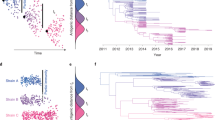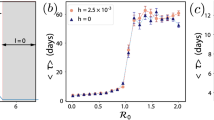Abstract
An important issue in population biology is the dynamic interaction between pathogens. Interest has focused mainly on the indirect interaction of pathogen strains, mediated by cross immunity1,2,3,4. However, a mechanism has recently been proposed for ‘ecological interference’ between pathogens through the removal of individuals from the susceptible pool after an acute infection. To explore this possibility, we have analysed and modelled historical measles and whooping cough records. Here we show that ecological interference is particularly strong when fatal infections permanently remove susceptibles. Disease interference has substantial dynamical consequences, making multi-annual outbreaks of different infections characteristically out of phase. So, when disease prevalence is high and is associated with significant mortality, it might be impossible to understand epidemic patterns by studying pathogens in isolation. This new ecological null model has important consequences for understanding the multi-strain dynamics of pathogens such as dengue and echoviruses.
This is a preview of subscription content, access via your institution
Access options
Subscribe to this journal
Receive 51 print issues and online access
$199.00 per year
only $3.90 per issue
Buy this article
- Purchase on Springer Link
- Instant access to full article PDF
Prices may be subject to local taxes which are calculated during checkout



Similar content being viewed by others
References
Gog, J. R. & Swinton, J. A. A status-based approach to multiple strain dynamics. J. Math. Biol. 44, 169–184 (2002)
Gupta, S., Ferguson, N. M. & Anderson, R. M. Chaos, persistence and evolution of strain structure in antigenically diverse infectious agents. Science 280, 912–915 (1998)
Gomes, M. G. M., Medley, G. F. & Nokes, D. J. On the determinants of population structure in antigenically diverse pathogens. Proc. R. Soc. Lond. B 269, 227–233 (2002)
Dietz, K. Epidemiologic interference of virus populations. J. Math. Biol. 8, 291–300 (1979)
Creighton, C. A History of Epidemics in Britain (Cambridge Univ. Press, Cambridge, 1894)
Rohani, P., Earn, D. J. D., Finkenstadt, B. F. & Grenfell, B. T. Population dynamic interference among childhood diseases. Proc. R. Soc. Lond. B 265, 2033–2041 (1998)
Anderson, R. M. & May, R. M. Infectious Diseases of Humans: Dynamics and Control (Oxford Univ. Press, Oxford, 1991)
Earn, D. J. D., Rohani, P., Bolker, B. M. & Grenfell, B. T. A simple model for complex dynamical transitions in epidemics. Science 287, 667–670 (2000)
Rand, D. A. & Wilson, H. B. Chaotic stochasticity: a ubiquitous source of unpredictability in epidemics. Proc. R. Soc. Lond. B 246, 179–184 (1991)
McLean, A. & Anderson, R. Measles in developing countries part I. Epidemiological parameters and patterns. Epidemiol. Infect. 100, 111–133 (1988)
Anderson, R. M. & May, R. M. Directly transmitted infectious diseases: control by vaccination. Science 215, 1053–1060 (1982)
Schenzle, D. An age-structured model of pre- and post-vaccination measles transmission. IMA J. Math. Appl. Med. Biol. 1, 169–191 (1984)
Rohani, P., Earn, D. J. D. & Grenfell, B. T. Opposite patterns of synchrony in sympatric disease metapopulations. Science 286, 968–971 (1999)
Butler, W. Measles. Proc. R. Soc. Med. 6, 120–153 (1913)
Kamo, M. & Sasaki, A. The effects of cross-immunity and seasonal forcing in a multi-strain epidemic model. Physica D 165, 228–241 (2002)
Wenjie, W. Control of dengue/dengue haemorrhagic fever in china. Dengue Bull. 21 〈http://w3.whosea.org/DengueBulletin21/ch3f.htm〉 (1997)
Focks, D. A., Brenner, R. J., Hayes, J. & Daniels, E. Transmission thresholds for dengue in terms of Aedes aegypti pupae per person with discussion of their utility in source. Am. J. Trop. Med. Hyg. 62, 11–18 (2000)
Hales, S., de Wet, N., Maindonald, J. & Woodward, A. Potential effect of population and climate changes on global distribution of dengue fever: an empirical model. Lancet 360, 830–834 (2002)
Kurane, I., Mady, B. J. & Ennis, F. A. Antibody-dependent enhancement of dengue virus infection. Rev. Med. Virol. 1, 211–222 (1991)
Behrman, R. E. & Kliegman, R. M. Nelson Essentials of Pediatrics (Saunders, Philadelphia, 1998)
Cherry, J. D. Pertussis in adults. Ann. Intern. Med. 128, 64–66 (1998)
Miller, E. & Gay, N. Epidemiological determinants of pertussis. Dev. Biol. Stand. 89, 15–23 (1997)
Keeling, M. J., Rohani, P. & Grenfell, B. T. Seasonally forced disease dynamics explored as switching between attractors. Physica D 148, 317–335 (2001)
Butler, W. Whooping cough and measles. Proc. R. Soc. Med. 40, 384–398 (1947)
Bartlett, M. S. Measles periodicity and community size. J. R. Stat. Soc. 1, 48–59 (1957)
Soper, H. E. The interpretation of periodicity in disease prevalence. J. R. Stat. Soc. 92, 34–73 (1929)
Linnert, L. A statistical report on measles notifications in Manchester, 1917–1951. (Department of Mathematical Statistics, Manchester, UK, 1954)
Grenfell, B. T., Bjornstad, O. N. & Kappey, J. Travelling waves and spatial hierarchies in measles epidemics. Nature 414, 716–723 (2001)
Torrence, C. & Compo, G. P. A practical guide to wavelet analysis. Bull. Am. Meteorol. Soc. 79, 61–78 (1998)
Buonaccorsi, J. P., Elkington, J. S., Evans, S. R. & Liebhold, A. M. Measuring and testing for spatial synchrony. Ecology 82, 1668–1679 (2001)
Acknowledgements
We thank O. Bjornstad, M. Boots, D. Gubler and H. Wearing for comments on this manuscript.
Author information
Authors and Affiliations
Corresponding author
Ethics declarations
Competing interests
The authors declare that they have no competing financial interests.
Rights and permissions
About this article
Cite this article
Rohani, P., Green, C., Mantilla-Beniers, N. et al. Ecological interference between fatal diseases. Nature 422, 885–888 (2003). https://doi.org/10.1038/nature01542
Received:
Accepted:
Issue Date:
DOI: https://doi.org/10.1038/nature01542
This article is cited by
-
Spatio-temporal trends in richness and persistence of bacterial communities in decline-phase water vole populations
Scientific Reports (2020)
-
How climate change can affect cholera incidence and prevalence? A systematic review
Environmental Science and Pollution Research (2020)
-
Spatiotemporal spread of sarcoptic mange in the red fox (Vulpes vulpes) in Switzerland over more than 60 years: lessons learnt from comparative analysis of multiple surveillance tools
Parasites & Vectors (2019)
-
Double trouble: co-infections of chytrid fungi will severely impact widely distributed newts
Biological Invasions (2019)
-
An agent-based model simulation of influenza interactions at the host level: insight into the influenza-related burden of pneumococcal infections
BMC Infectious Diseases (2017)
Comments
By submitting a comment you agree to abide by our Terms and Community Guidelines. If you find something abusive or that does not comply with our terms or guidelines please flag it as inappropriate.



